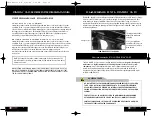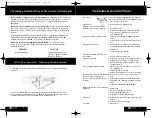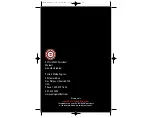
11
10
DO NOT EXCEED RECOMMENDED INPUT OR OPERATING PRESSURE.
FILLING COMPRESSED
GAS / A I R
An overfill of any compressed gas or air cylinder can cause
the safety burst disk (Figure 5) on the cylinder to burst, or the
cylinder itself to rupture. A cylinder may rupture with
extremely dangerous, and potentially lethal force. Use
properly rated discs only. Inspect the burst disc for a vent
hole. If no hole is present contact a local store or PMI
immediately. DO NOT FILL!
A scale must be used for all CO2 fills to prevent an overfill. A pressure gauge must be used
for all compressed gas or air fills to prevent an overfill.
Fills must be performed by qualified personnel. A cylinder must not be filled beyond the
cylinder’s capacity per the U.S. Department of Transportation. A cylinder’s rated capacity
appears on the cylinder itself.
Use only CO2 tanks with an anti-siphon tube installed for best results.
Figure 5. Safety burst
disk.
The EVIL OMEN
™
paintball marker may be powered by anti-siphon CO2 but it is
recommended that Nitrogen or Compressed Air be used for best performance.
THE SAFETY RULES FOR HANDLING COMPRESSED GAS OR AIR MUST BE
FOLLOWED AT ALL TIMES.
Figure 3. Valve-cylinder
connection.
Figure 4. Valve-cylinder
connection.
COMPRESSED GAS/AIR
WARNING
COMPRESSED GAS/AIR
WARNING
WARNING
O P E RATING PRESSURE AND INPUT
P R E SS U R E
• Operating pressure range: 250-500 p.s.i.
• Recommended maximum input pressure is 500 p.s.i. for marker.
• Maximum inlet to regulator 1000 p.s.i.
• Do not exceed recommended pressures.
DO NOT LEAVE CYLINDER OR PRESSURIZED MARKER IN DIRECT SUNLIGHT
OR EXPOSED TO HEAT SOURCE. INCREASED TEMPERATURE WILL INCREASE
THE PRESSURE OF COMPRESSED GAS OR AIR TO DANGEROUS LEVELS. THIS IS
ESPECIALLY TRUE WITH CO
2
.
VA LV E - CYLINDER CONNECTION
The valve on a cylinder is to remain screwed into the cylinder;
Figures 3 and 4. Should it loosen, the cylinder may detach from
the valve with extremely dangerous force. Call manufacturer
or take to qualified personnel for inspection if valve and cylinder
begin to separate.
Every time a cylinder is filled, the connection between the valve
and cylinder must be inspected. If any looseness or leak is
detected between the valve and the cylinder, do not fill. Drain
cylinder and call manufacturer or take to qualified personnel
for inspection.
A COMPRESSED GAS OR AIR CYLINDER IS A PRESSURE VESSEL. FOLLOW RULES FOR
SAFE HANDLING OF COMPRESSED GAS OR AIR. ALL FILLING OF COMPRESSED
GAS OR AIR CYLINDERS, AND ALL REPAIRS TO A MARKER’S AIR SYSTEM OR ITS
COMPONENTS MUST BE PERFORMED BY QUALIFIED PERSONNEL.
DO NOT OVERFILL ANY CYLINDER. AN OVERFILL CAN CAUSE THE SAFETY BURST DISK
OR THE CYLINDER ITSELF TO RU P T U R E .
HYDROSTATIC TESTING DATE
Many cylinders are required by the U. S. Department of Transportation to be hydro tested
at periodic interva l s, with the interval varying according to cylinder type. The date of the
c y l i n d e r ’s initial or later testing appears on the cylinder. A cylinder that is out of date for
hydrostatic testing must not be filled or used.
Omen Manual 2.0 6/21/05 9:56 AM Page 10



































